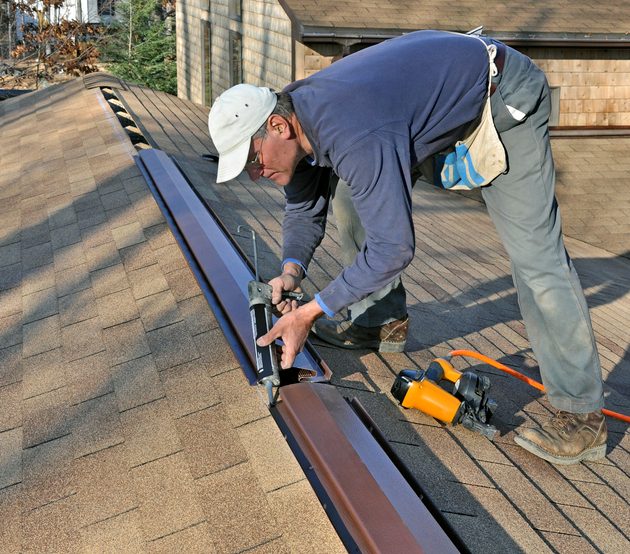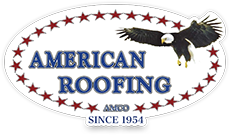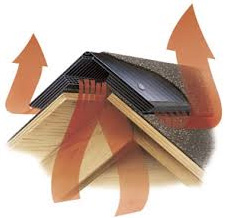
One of the best ways to ensure proper roof ventilation, especially during Utah’s hot summer weather, is through ridge vents. These vents provide a natural way for cool air to flow through your attic and hot air to escape, which helps keep your home more comfortable.
But what is a ridge vent? How do they work? What are the benefits? We’ll provide the answers to each of these questions and more below.
What Is a Ridge Vent?
A ridge vent is usually made from aluminum or a mesh-type material and is installed underneath the final layer of shingles to create airflow across the exterior roof. It draws hot, moist attic air out through the ridge vent and pulls fresh air into the attic through the soffit vents. This helps to reduce cooling costs and eliminates potential damage to your roof.
How to Install a Ridge Vent
Installing a ridge vent is fairly easy. However, before you begin, it’s important that the vent has an equal intake of cool, fresh air and output of warm, moist air. This ensures that your attic is getting the right amount of ventilation. Once you’ve confirmed air will be moving properly, follow these steps to install a metal ridge vent:
- Remove all cap shingles from your roof ridge followed by the wood sheathing.
- Insert the vent plugs and connect the ridge vents to the connectors.
- Cut the end of the vent so it fits tightly against the end of the ridge vents.
- Line up the fastened ridge vents with the slot along the roof ridge.
- Fasten the ridge vents into place using nails.
- Once attached, place straps over the joints and use nails to hold them in place.
If you’re wondering whether a ridge vent should go all the way across a roof, it depends. You don’t want to cut ridge vents all the way to the edge, but you can install vent caps all the way to the edge. The aesthetic you want will determine how far you place the vents. For a more seamless look, vents should extend to the edge.
Ridge vents on metal roofs can be installed in a similar fashion. For proper installation, it’s recommended to leave a two inch wide opening to ensure your roof is getting the right amount of ventilation.
Benefits of Having a Ridge Vent Installed in Utah
If you’re in Salt Lake City and considering installing a ridge vent, you might want to know how it would benefit you. There are many pros to having a ridge vent installed in Salt Lake City. Here are a few things to take into account:
- Expands Roof Life: The extreme temperatures in Salt Lake City can heavily impact your roof in a negative way. A ridge vent helps to properly ventilate your roof, thus making it last longer.
- Saves Money: If your attic is overheating, your HVAC system is working overtime. A ridge vent in your attic can move air and ventilate the area.
- Keeps Your Home Temperate: With a ridge vent, you won’t have to change the thermostat every five minutes. Your house will be comfortable year-round.
Roof Ridge Vents: Pros and Cons
If you’re wondering whether ridge vents are worth it, they do benefit your home in several ways. However, there are some downsides to installing these vents.
Pros:
Ridge vents help to keep bees, wasps, mice, and rats from entering your attic. In addition, a roof that is properly ventilated:
- Reduces heat build-up, which helps to keep your home cool and comfortable.
- Can reduce the load on HVAC systems, which can result in a lower electric bill.
- Helps prevent ice dams from forming which decreases the chance of damage to your roof, attic, and walls.
- Reduces moisture build-up, decreasing the chance of leaks forming.
- Helps extend the lifespan of shingles by ensuring heat is able to escape from your roof and attic.
Cons:
Some ridge vent problems include:
- Some ridge vents are prone to leak during heavy wind-driven rains. The one means of preventing leaks is to replace vents with something more water-tight.
- Some homes may not get the proper ventilation from ridge vents depending on the energy-efficient nature of the property.
While it’s easy to overlook attic ventilation as part of seasonal roof maintenance, proper ventilation can help protect your entire property. Ridge vents are one of the most popular choices for attic insulation in Salt Lake City and throughout Utah as they allow for proper airflow to reduce condensation and heat, keeping your home more comfortable.
Do you need a ridge vent? For proper installation, leave it up to the pros. Contact American Roofing for a quote today.

